Invasive Species: Artemisia absinthium, Absinth Wormwood
Absinth wormwood (absinthium, common wormwood) is an invasive herbaceous perennial plant that can grow up to 5 ft. (1.5 m) tall. It has many branching stems arising from a woody base. Leaves are alternate, gray-green, 1 to 4 in. (2.5 to 10 cm) long, and give off a strong sage-like scent when crushed. Lower leaves are divided into two to three segments, and the upper leaves are not divided. Flowering occurs in midsummer when pale yellow tubular flowers develop in drooping heads in the axils of the leaves. A single plant can produce 50,000 seeds. Absinth wormwood invades open and disturbed sites such as pastures, rangelands, crop land, stream banks, prairies, and old fields. The plant is native to Europe and was first introduced into the United States in the mid-1800s.
What are invasive species and why should we be concerned about them?
Taxonomy: Scientific and Common Names for This Species
Asterales > Asteraceae > Artemisia absinthium L.
Synonym(s): absinthium
Artemisia absinthium – USDA PLANTS Profile
Distribution Maps
Absinth wormwood – The reported distribution of this invasive species across the United States. (Source: Invasive Plant Atlas of the United States)
Up-to-the-minute distribution maps and why they are important
Reporting This Invasive Species
What is the best way and place to report the occurrence of an invasive species?
How to report an invasive species sighting to EDDMapS – Early Detection & Distribution Mapping System
EDDMapS – Report an invasive species to EDDMapS
Cooperative Extension Offices – Find your local Cooperative Extension office on this map provided by USDA
How to Identify
This invasive species can be identified by looking for the characteristics described in the paragraphs that follow.
Plant
An invasive herbaceous perennial plant that can grow up to 5 ft. (1.5 m) tall.
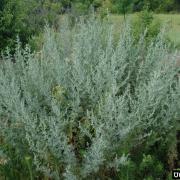 |
 |
| Chris Evans, University of Illinois,., bugwood.org | Chris Evans, River to River CWMA, bugwood.org |
Foliage
Leaves are alternate, gray-green, 1 to 4 in. (2.5 to 10 cm) long, and give off a strong sage-like scent when crushed. Lower leaves are divided into two to three segments, and the upper leaves are not divided.
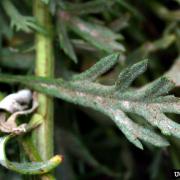 |
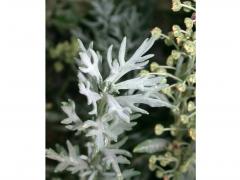 |
|
Mary Ellen (Mel) Harte, bugwood.org |
Mary Ellen (Mel) Harte, bugwood.org |
Flower
Flowering occurs in midsummer when pale yellow tubular flowers develop in drooping heads in the axils of the leaves.
|
|
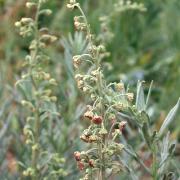 |
|
Mary Ellen (Mel) Harte, bugwood.org |
Mary Ellen (Mel) Harte, bugwood.org |
Fruit
A single plant can produce 50,000 seeds.
 |
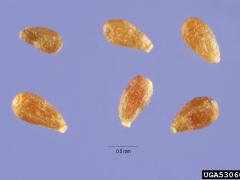 |
| Mary Ellen (Mel) Harte, bugwood.org | Steve Hurst, USDA NRCS PLANTS Database, bugwood.org |
Native Species That Resemble Absinth Wormwood
Artemisia ludoviciana, Louisiana wormwood – Images at invasive.org
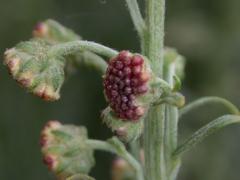 |
 |
| Mary Ellen (Mel) Harte, bugwood.org |
Mary Ellen (Mel) Harte, bugwood.org |
Artemisia campestris, common sagewort – Images at invasive.org
 |
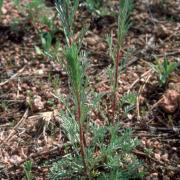 |
| Mary Ellen (Mel) Harte, bugwood.org | Dave Powell, USDA Forest Service (retired) , bugwood.org |
Additional Images for Absinth Wormwood
Absinth wormwood – Images at Invasive.org
Learning Resources for Absinth Wormwood
Additional Information, Biology, Control and Management Resources
Control and management recommendations vary according to individual circumstances. Location, habitat, weather, and a variety of other conditions are factors that help determine the best treatment choice. To find the safest and most effective treatment for your situation, consult your state’s land-grant institution. If you will use chemicals as part of the control process, always refer to the product label.
United States Land-Grant University System – Find your land-grant university’s College of Agriculture, Cooperative Extension Service, or other related partner on this map provided by USDA.
Fire Effects Information System – USDA Forest Service
Element Stewardship Abstract – The Nature Conservancy
Fact Sheet – Missouri Botanical Garden
Invasive.org – Center for Invasive Species and Ecosystem Health
Fact Sheet – Colorado Department of Agriculture
Absinth Wormwood – North Dakota Department of Agriculture
Absinth Wormwood – Stevens County Noxious Weed Control Board

